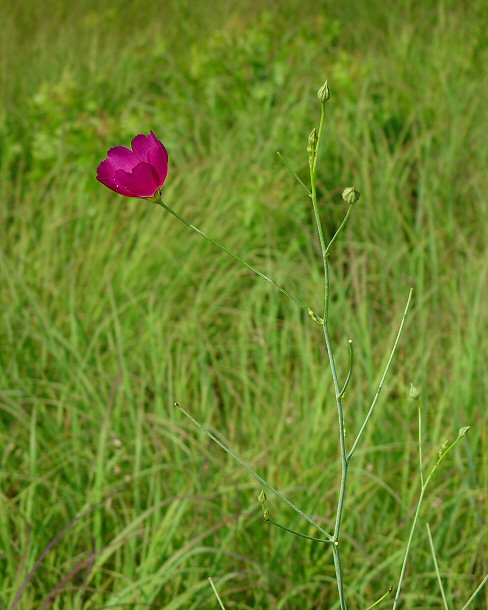Callirhoe digitata Nutt.
Fringed Poppy Mallow

Native
CC = 8
CW = 5
MOC = 14
© DETenaglia
Callirhoe digitata Nutt.Fringed Poppy Mallow | |
 |
Native CC = 8 CW = 5 MOC = 14 |
© DETenaglia |
|
Family - Malvaceae Habit - Perennial forb from a thickened taproot or corm. Stems - Ascending to erect, to 1.2 m, branching in the inflorescence, single from the base, glabrous, rarely sparesely pubescent near nodes, glaucous, terete, stout.
Leaves - Basal and alternate, petiolate, palmately compound. Basal leaf petioles 7-30 cm long, glaucous, glabrous or more commonly pubescent with simple hairs. Leaf blades 3-13 cm long, kidney-shaped, broadly ovate, or nearly circular in outline, with 3-9 deep palmate lobes, these often 1 or 2 times 2- or 3-lobed again, the ultimate segments usually linear, to 5 mm broad, the margins entire or with few shallow lobes or teeth, the upper surface glabrous or pubescent with simple hairs, the undersurface usually pubescent with simple hairs. Upper leaves with the ultimate divisions becoming filiform, glabrous. Stipules mostly shed before flowering, 6.0-7.5 mm long, linear to narrowly lanceolate.
Inflorescence - Loose elongate panicles of 6-20 flowers. Peduncles to 10 cm long, glabrous, thin, expanding with age. Bractlets subtending calyx absent. Flowers - Calyces 7-10 mm long, bell-shaped, 5 mm long, the outer surface glabrous, 5-lobed, the lobes 3.5-7.0 mm long, 3-nerved, lanceolate to narrowly ovate or narrowly triangular. Petals 15-26 mm long, to 2 cm long, obovate, rounded at the apex, deep rose to wine red or purplish red, usually with a lighter area toward the base, glabrous. Stamens numerous, the staminal column 1 cm long, circular in cross-section, without a low crown of teeth at the tip, pubescent. Filaments with free portion to 2-3 mm long. Anthers pinkish, 1 mm long. Pistils with 9-23 locules, the carpels arranged in a loose flattened ring. Styles about 15, white, glabrous, fused most of their length, each branch with a single linear stigmatic area along the inner side toward the tip. Ovary light green, 3 mm broad in flower (quickly expanding in fruit), typically 15-carpellate, one ovule per carpel.
Fruits - Schizocarps 7-9 mm in diameter, with 12-16 mericarps. Mericarps indehiscent, 3.5-4.5 mm long, wedge-shaped, the surfaces glabrous, the sides of the fertile portion with a reticulate pattern of thickenings, separated from the inconspicuous sterile portion but without a differentiated collar. Seeds 2-3 mm long, kidney-shaped, black or less commonly dark brown.
Flowering - May - September. Habitat - Dry forests, upland prairies, calcareous glades, roadsides. Origin - Native to U.S. Lookalikes - Other members of the genus, especially Callirhoe involucrata and Callirhoe bushii. Other info. - This striking prairie species can be found mainly in the southwest corner of Missouri. Its U.S. range is relatively limited, mostly limited to Missouri, Arkansas, and Oklahoma. The flowers of this plant are similar to those of several other species in the genus, having an amazingly rich, saturated color which is impossible to miss. This particular species is distinguished from the others by its highly divided leaves with very narrow ultimate segments. The stems are also both glabrous and glaucous. This is a perennial species which would make and excellent garden subject. It grows well from seed and is richly deserving of more widespread cultivation. Photographs taken at Robert E. Talbot Conservation Area, Lawrence County, MO., 7-4-03. |